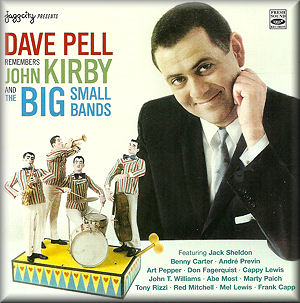The Big Small Bands
1. Then I'll Be Happy
2. A Smo-o-o-oth One
3. In An 18th Century Drawing Room
4. Summit Ridge Drive
5. At The Codfish Ball
6. Jumpin' With Symphony Sid
7. Popo
8. Boplicity
9. Dark Eyes
10. Viva Zapata
11. Walking Shoes
12. Mountain Greenery
I Remember John Kirby
13. Rose Room
14. Royal Garden Blues
15. Anitra's Dance
16. It Feels Good
17. Tootsie Roll
18. Double Walk
19. Undecided
20. Blue Skies
21. Coquette
22. Opus #5
23. 20th Century Closet
Big Small Bands: Collective Personnel
Dave Pell - Tenor sax, baritone sax
Jack Sheldon, Frank Beach, Don Fagerquist, Cappy Lewis
- Trumpet
Bob Enevoldsen - Valve trombone
Arthur Maebe - French horn
Philip Stephens - Tuba
Hoyt Bohanon - Trombone
Art Pepper - Alto sax
Abe Most - Clarinet
Marty Berman, Ronny Lang - Baritone sax
Marty Paich, André Previn - Piano
John T. Williams - Piano, harpsichord
Tony Rizzi, Bob Gibbons - Guitar
Buddy Clark, Red Mitchell - Bass
Mel Lewis, Frank Capp, Shelly Manne - Drums
I Remember John Kirby
Dave Pell - Clarinet
Benny Carter - Alto sax
Ray Linn - Trumpet
John T. Williams - Piano
Lyle Ritz - Bass
Frank Capp - Drums
Dave Pell is an almost forgotten name nowadays, although he was prominent when West Coast jazz was at the height of its popularity. This CD reissues two LPs, from 1959 and 1960 respectively, which both played homage to small groups. Confusingly, the front cover lists the albums in the reverse order to how they appear on the CD. The Big Small Bands is a tribute to the small groups which emerged from the swing era's big bands. These include combos led by Benny Goodman, Artie Shaw, Gene Krupa, Gerry Mulligan and John Kirby (who is also the theme of the whole second LP). Tributes like this can be lifeless imitations but Pell's sincerity and the new solos add spirit to authenticity.
We begin with John Kirby's 1939 arrangement of Then I'll Be Happy. Kirby's sextet was notable for its tight arrangements and virtuosic playing by the likes of Charlie Shavers, Russell Procope and Billy Kyle. As on the second LP, Dave Pell's group captures the essence of the Kirby sound, with Abe Most's clarinet ringing out above the ensemble and Cappy Lewis capturing the brilliant trumpet style of Charlie Shavers. Abe Most also does a respectable impression of Benny Goodman in A Smo-o-o-oth One. These are not characterless imitations - indeed, Dave Pell's smooth tenor sax adds a new sound to the Goodman number.
In An 18th-Century Drawing Room was a classic recording by the Raymond Scott Quartet in 1938, here reproduced with Abe Most and Dave Pell contributing convincing cod-Mozart playing. Artie Shaw's Gramercy Five made Summit Ridge Drive a classic and Dave Pell imports John T. Williams on harpsichord to achieve the right sound. Dave Pell pays tribute to Lester Young in Jumpin' With Symphony Sid and the arrangement of Popo perfectly catches the style of Shorty Rogers' Giants, with Jack Sheldon sounding exactly like Shorty.
Boplicity likewise is a persuasive representation of the "Birth of the Cool" sessions. Apparently Dave Pell had a special "Charlie Ventura" mouthpiece with which to play the Gene Krupa Trio's definitive version of Dark Eyes. And his group manages to reproduce the contrapuntal thrill of Gerry Mulligan's Walking Shoes. The last track - Mountain Greenery - has Dave Pell imitating himself, as it was a hit for him in 1955.
Dave Pell says that the first group he ever led was modelled on the John Kirby Sextet, and the second LP witnesses his devotion to the John Kirby methods. As the sleeve-note points out, "What Kirby did was put small band music on the same level of careful preparation and written organization as the big swing bands that then dominated the scene". Dave Pell emulates its clean-lined precision, with Benny Carter making an able substitute for Russell Procope on alto sax. Dave himself takes up the clarinet for the first time in years to catch the spirit of Buster Bailey. We can but hope that listeners will be led by hearing these tracks to go back and discover or rediscover John Kirby's brilliant originals.
This whole 70-minute album is a sort of jazz history lesson in miniature and well worth getting for numerous reasons.
Tony Augarde
www.augardebooks.co.uk
